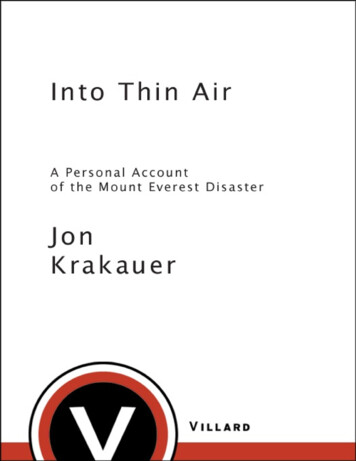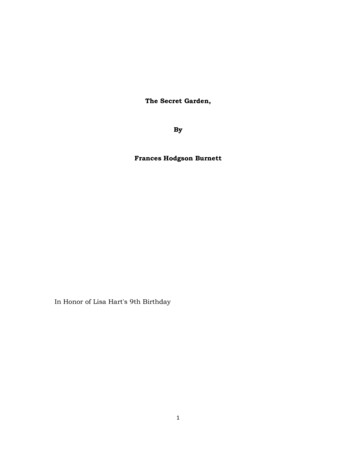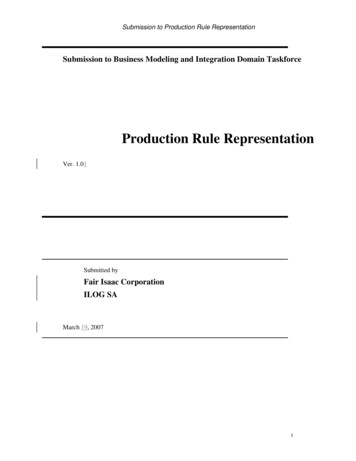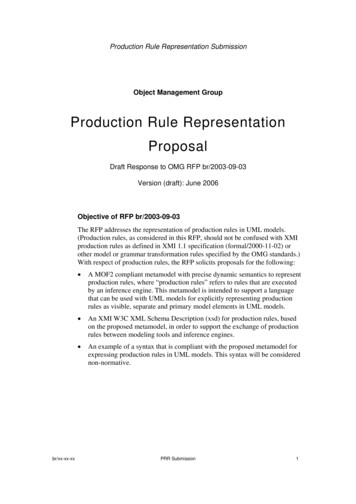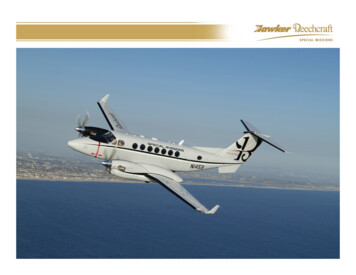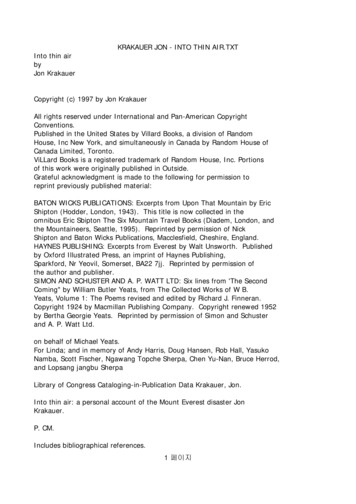
Transcription
Into thin airbyJon KrakauerKRAKAUER JON - INTO THIN AIR.TXTCopyright (c) 1997 by Jon KrakauerAll rights reserved under International and Pan-American CopyrightConventions.Published in the United States by Villard Books, a division of RandomHouse, Inc New York, and simultaneously in Canada by Random House ofCanada Limited, Toronto.ViLLard Books is a registered trademark of Random House, Inc. Portionsof this work were originally published in Outside.Grateful acknowledgment is made to the following for permission toreprint previously published material:BATON WICKS PUBLICATIONS: Excerpts from Upon That Mountain by EricShipton (Hodder, London, 1943). This title is now collected in theomnibus Eric Sbipton The Six Mountain Travel Books (Diadem, London, andthe Mountaineers, Seattle, 1995). Reprinted by permission of NickShipton and Baton Wicks Publications, Macclesfield, Cheshire, England.HAYNES PUBLISHING: Excerpts from Everest by Walt Unsworth. Publishedby Oxford Illustrated Press, an imprint of Haynes Publishing,Sparkford, Nr Yeovil, Somerset, BA22 7jj. Reprinted by permission ofthe author and publisher.SIMON AND SCHUSTER AND A. P. WATT LTD: Six lines from 'The SecondComing" by William Butler Yeats, from The Collected Works of W B.Yeats, Volume 1: The Poems revised and edited by Richard J. Finneran.Copyright 1924 by Macmillan Publishing Company. Copyright renewed 1952by Bertha Georgie Yeats. Reprinted by permission of Simon and Schusterand A. P. Watt Ltd.on behalf of Michael Yeats.For Linda; and in memory of Andy Harris, Doug Hansen, Rob Hall, YasukoNamba, Scott Fischer, Ngawang Topche Sherpa, Chen Yu-Nan, Bruce Herrod,and Lopsang jangbu SherpaLibrary of Congress Cataloging-in-Publication Data Krakauer, Jon.Into thin air: a personal account of the Mount Everest disaster JonKrakauer.P. CM.Includes bibliographical references.1 페이지
KRAKAUER JON - INTO THIN AIR.TXTISBN 0-679-45752-61. Mountaineering accidents-Everest, Mount (China and Nepal).2. Mount Everest Expedition (1996). 3. Krakauer, Jon. I. Title.GV199.44.E85K725 1997 796.5'2"-095496--dc2 i 96-30031 Random Housewebsite address: http://www.randomhouse.com/Printed in the United States of America on acid-free paperBook design by Caroline CunninghamMen play at tragedy because they do not believe in the reality of lifetragedy which is actually being staged in the civilized world.Jose Ortega GassetINTRODUCTIONIn March 1996, Outside magazine sent me to Nepal to participate in, andwrite about, a guided ascent of Mount Everest. I went as one of eightclients on an expedition led by a well-known guide from New Zealandnamed Rob Hall. On May 10 I arrived on top of the mountain, but thesummit came at a terrible cost.Among my five teammates who reached the top, four, including Hall,perished in a rogue storm that blew in without warning while we werestill high on the peak. By the time I'd descended to Base Camp nineclimbers from four expeditions were dead, and three more lives would belost before the month was out.The expedition left me badly shaken, and the article was difficult towrite. Nevertheless, five weeks after I returned from Nepal Idelivered a manuscript to Outside, and it was published in theSeptember issue of the magazine. Upon its completion I attempted toput Everest out of my mind and get on with my life, but that turned outto be impossible.Through a fog of messy emotions, I continued trying to make sense ofwhat had happened up there, and I obsessively mulled over thecircumstances of my companions' deaths.The Outside piece was as accurate as I could make it under thecircumstances, but my deadline had been unforgiving, the sequence ofevents had been frustratingly complex, and the memories of thesurvivors had been badly distorted by exhaustion, oxygen depletion, andshock. At one point during my research I asked three other people torecount an incident all four of us had witnessed high on the mountain,2 페이지
KRAKAUER JON - INTO THIN AIR.TXTand none of us could agree on such crucial facts as the time, what hadbeen said, or even who had been present. Within days after the Outsidearticle went to press, I discovered that a few of the details I'dreported were in error. Most were minor inaccuracies of the sort thatinevitably creep into works of deadline journalism, but one of myblunders was in no sense mmor, and it had a devastating impact on thefriends and family of one of the victims.Only slightly less disconcerting than the article's factual errors wasthe material that necessarily had to be omitted for lack of space.Mark Bryant, the editor of Outside, and Larry Burke, the publisher, hadgiven me an extraordinary amount of room to tell the story: they ranthe piece at 17,000 words-four or five times as long as a typicalmagazine feature. Even so, I felt that it was much too abbreviated todo justice to the tragedy The Everest climb had rocked my LIFE to itscore, and it became desperately important for me to record the eventsin complete detail, unconstrained by a limited number of column inches.This book is the fruit of that compulsion.The unreliability of the human mind at high altitude The staggeringexcessively on my made the research problematic. To avoid relying onmy own perceptions, I interviewed most of the protagonists at greatlength and on multiple occasions. When possible I also corroborated p,where logs maintained by people at Base Cam details with radio clearthought wasn't in such short supply. Readers familiar with the Outsidearticle may notice discrepancies between certain details mainly mattersof time) reported in the magazine and those in the book; the revisionsreflect new information that has come to light since publication of themagazine piece. Several authors and editors I respect counseled me notto write the book as quickly as I did; they urged me to wait two orthree years and put some distance between me and the expedition inorder to gain some crucial perspective. Their advice was sound, but inthe end I ignored it-mostly because what happened on the mountain wasthe book might purge gnawing my guts out.I thought that writing Everest from my life.it hasn't, of course. Moreover, I agree that readers are often ct ofcatharsis, as I have poorly served when an author writes as I have donehere. But I hoped something would be gained by spilling my soul in thecalamity's immediate aftermath, in the roil and torment of the moment.I wanted my account to have a raw, ruthless sort of honesty that seemedin danger of leaching away with the passage of time and the dissipationof anguish.Some of the same people who warned me against writing hastily had alsocautioned me against going to Everest in the first place.There were many, many fine reasons not to go, but attempting to climbEverest is an intrinsically irrational act-a triumph of desire oversensibility. Any person who would seriously consider it is almost by3 페이지
KRAKAUER JON - INTO THIN AIR.TXTdefinition beyond the sway of reasoned argument.The plain truth is that I knew better but went to Everest anyway.And in doing so I was a party to the death of good people, which issomething that is apt to remain on my conscience for a very long time.Jon Krakauer Seattle November 1996It would seem almost as though there were a cordon drawn round theupper part of these great peaks beyond which no man may go. The truthof course lies in the fact that, at altitudes of 25,000 feet andbeyond, the effects of low atmospheric Pressure upon the human body areso severe that really difficult mountaineering is impossible and theconsequences even of a mild storm may be deadly, that nothing but themost perfect conditions of weather and snow offers the slightest chanceof success, and that on the last lap of the climb no party is in aposition to choose its day.No, it is not remarkable that Everest did not yield to the first fewattempts; indeed, it would have been very surprising and not a littlesad if it had, for that is not the way of great mountains. Perhaps wehad become a little arrogant with our fine new technique of ice-clawand rubber slipper, our age of easy mechanical conquest. We hadforgotten that the mountain still holds the master card, that it willgrant success only in its own good time. Why else does mountaineeringretain its deep fascination?Eric Shipton, in 1938 Upon That Mountain traddling the top of theworld, one foot in China and the other in Nepal, I cleared the ice frommy oxygen mask, hunched a shoulder against the wind, and staredabsently down at the vastness of Tibet. I understood on some dim,detached level that the sweep of earth be neath my feet was aspectacular sight. I'd been fantasizing about this moment, and therelease of emotion that would accompany it, for many months. But nowthat I was finally here, actually standing on the summit of MountEverest, I just couldn't summon the energy to care.It was early in the afternoon of May 10, 1996. I hadn't slept infifty-seven hours. The only food I'd been able to force down over thepast three days was a bowl of ramen soup and a handful of rice peanutM&Ms. Weeks of violent coughing had left me with two separated ribsthat made ordinary breathing an excruciating trial. At 29,028 feet upin the troposphere, so little oxygen was reaching my brain that mymental capacity was that of a slow child. Under the circumstances, Iwas incapable of feeling much of anything except cold and tired.I'd arrived on the summit a few minutes after Anatoli Boukreev, aRussian climbing guide working for an American commercial expedition,and just ahead of Andy Harris, a guide on the New Zealand-based team towhich I belonged. Although I was only slightly acquainted withBoukreev, I'd come to know and like Harris well durpped four quick4 페이지
KRAKAUER JON - INTO THIN AIR.TXTphotos of Harris and the preceding six weeks. I sna Boukreev strikingsummit poses, then turned and headed down. My m. All told, I'd spentless than five minutes on the roof of the world.looking A moment later, I paused to take another photo, this on theSoutheast Ridge, the route we had ascended. Training my down lens on apair of climbers approaching the summit, I noticed something that untilthat moment had escaped my attention. To the south, where the sky hadbeen perfectly clear just an hour earlier, a blanket of clouds now hidPumori Ama Dablarn, and the other lesser peaks surrounding Everest.Later-after six bodies had been located, after a search for two othershad been abandoned, after surgeons had amputated the gangrenous righthand of my teammate Beck Weathers-people would ask why, if the weatherhad begun to deteriorate, had climbers on the upper mountain not heededthe signs? Why did veteran Himalayan guides keep moving upward,ushering a gaggle of relatively inexperienced amateurs--each of whomhad paid as much as 65,000 to be taken safely up Everest-into anapparent death trap?Nobody can speak for the leaders of the two guided groups involved,because both men are dead. But I can attest that nothing I saw earlyon the afternoon of May 10 suggested that a murderous storm was bearingdown. To my oxygen-depleted mind, the clouds drifting up the grandvalley of ice known as the Western Cum* looked innocuous, wispy,insubstantial. Gleaming in the brilliant midday sun, they appeared nodifferent from the harmless puffs of convection condensation that rosefrom the valley almost every afternoon.As I began my descent I was extremely anxious, but my concern hadlittle to do with the weather: a check of the gauge on my oxygen tankhad revealed that it was almost empty. I needed to get down, fast.The uppermost shank of Everest's Southeast Ridge is a slender, heavilycorniced fin of rock and wind-scoured snow that snakes for a quartermile between the summit and a subordinate pinnacle known as the SouthSummit. Negotiating the serrated ridge presents no great technicalhurdles, but the route is dreadfully exposed. After leaving thesummit, fifteen minutes of cautious shuffling over a 7,000-foot abyssbrought me to the notorious Hillary Step, a pronounced notch in theridge that demands some technical maneuvering. As I clipped into afixed rope and prepared to rappel over the lip, I was greeted with analarming sight.Thirty feet below, more than a dozen people were queued up at the baseof the Step. Three climbers were already in the process of haulingthemselves up the rope that I was preparing to descend. Exercising myonly option, I unclipped from the communal safety line and steppedaside.The traffic jam was comprised of climbers from three expeditions: theteam I belonged to, a group of paying clients under the leadership of5 페이지
KRAKAUER JON - INTO THIN AIR.TXTthe celebrated New Zealand guide Rob Hall; another guided party headedby the American Scott Fischer; and a noncommercial Taiwanese team.Moving at the snail' pace that is the norm above 26,000 feet, thethrong labored up the Hillary Step one by one, while I nervously bidedmy time.The Western Cum, pronounced koom, was named by George Leigh Mallory,who first sbaw it during the initial Everest expedition of 1921 fromthe Lho La, a high pass on the border between Nepal and Tibet. Cum isa Welsh term for valley or cirque.after I did, soon pulled up Harris, who'd left the summit shortlybehind me. Wanting to conserve whatever oxygen remained in my tank, Iasked him to reach inside my backpack and turn off the valve on myregulator, which he did. For the next ten minutes I felt surprisinglygood. My head cleared. I actually seemed less tired than I had withthe gas turned On. Then, abruptly, I sensed that I was suffocating.My vision dimmed and my head began to spin. I was on the brink oflosing consciousness.Instead of turning my oxygen off, Harris, in his hypoxically impairedstate, had mistakenly cranked the valve open to full flow, draining thetank. I'd just squandered the last of my gas going nowhere.There was another tank waiting for me at the South Summit, 250 feetbelow, but to get there I would have to descend the most exposedterrain on the entire route without the benefit of supplemental oxygen.And first I had to wait for the mob to disperse. I removed my nowuseless mask, planted my ice ax into the mountain's frozen hide, and Iexchanged banal congratulations with the hunkered on the ridge. As"Hurry it up, hurry it up, climbers filing past, inwardly I wasfrantic: I silently pleaded. "While you guys are fucking around here,I'm losing brain cells by the millions!Most of the passing crowd belonged to Fischer's group, but near theback of the parade two of my teammates eventually appeared, Rob Halland Yasuko Namba. Demure and reserved, the forty-seven-year the oldestwoman old Namba was forty minutes away from becoming best to climbEverest and the second Japanese woman to reach the hig she point oneach continent, the so-called Seven Summits. Although weighed justninety-one pounds, her sparrowlike proportions disguised a formidableresolve; to an astounding degree, Yasuko had been propelled up themountain by the unwavering intensity of her desire.Later still, Doug Hansen arrived atop the Step. Another member of ourexpedition, Doug was a postal worker from a Seattle suburb who'd becomemy closest friend on the mountain. "It's in the bag!I yelled over the wind, trying to sound more upbeat than I felt.Exhausted, Doug mumbled something from behind his oxygen mask that Ididn't catch, shook my hand weakly, then continued plodding upward.At the very end of the line was Scott Fischer, whom I knew casuallyfrom Seattle, where we both lived. Fischer's strength and drive were6 페이지
KRAKAUER JON - INTO THIN AIR.TXTlegendary-in 1994 he'd climbed Everest without using bottled Oxygen-soI was surprised at how slowly he was moving and how hammered he lookedwhen he pulled his mask aside to say hello."Bruuuuuuce! " he wheezed with forced cheer, employing his trademarkfrat-boyish greeting. When I asked how he was doing, Fischer insistedthat he was feeling fine: "Just dragging ass a little today for somereason. No big deal." With the Hillary Step finally clear, I clippedinto the strand of orange rope, swung quickly around Fischer as heslumped over his ice ax, and rappelled over the edge.It was after three o'clock when I made it down to the South Summit. Bynow tendrils of mist were streaming over the 27,923 -foot top of Lhotseand lapping at Everest's summit pyramid. No longer did the weatherlook so benign. I grabbed a fresh oxygen cylinder, jammed it onto myregulator, and hurried down into the gathering cloud. Moments after Idropped below the South Summit, it began to snow lightly and visibilitywent to hell.Four hundred vertical feet above, where the summit was still washed inbright sunlight under an immaculate cobalt sky, my companions dalliedto memorialize their arrival at the apex of the planet, unfurling flagsand snapping photos, using up precious ticks of the Clock. None ofthem imagined that a horrible ordeal was drawing nigh.Nobody suspected that by the end of that long day, every minute wouldmatter.Far from the mountains in winter, I discovered the blurred photo ofEverest in Richard Halliburton's Book of Marvels. It was a miserablereproduction in which the jagged peaks rose white against a grotesquelyblackened and scratched sky. Everest itself, sitting back from thefront ones, didn't even appear highest, but it didn't matter It was;the legend said so. Dreams were the key to the picture, permitting aboy to enter it, to stand at the crest of the windswept ridge, to climbtoward the summit, now no longer far above.This was one of those uninhibited dreams that come free with growingup.I was sure that mine about Everest was not mine alone; the highestpoint on earth, unattainable, foreign to all experience, was there formany boys and grown men to aspire toward, Thomas F Hornbein Everest:The West Ridge The actual particulars of the event are unclear,obscured by the accretion of myth. But the year was 1852, and thesetting was the offices of the Great Trigonometrical Survey of India inthe northern hill station of Dehra Dun. According to the mostplausible version of what transpired, a clerk rushed into the chambersof Sir Andrew Waugh, India's surveyor general, and exclaimed that aBengali computer named Radhanath Sikhdar, working out of the Survey'sCalcutta bureau, had "discovered the highest mountain in the world."(In Waugh's day a computer was a job description rather than amachine.)7 페이지
KRAKAUER JON - INTO THIN AIR.TXTDesignated Peak XV by surveyors in the field who'd first measured theangle of its rise with a twenty-four-inch theodolite three yearsearlier, the mountain in question jutted from the spine of the Himalayain the forbidden kingdom of Nepal.Until Sikhdar compiled the survey data and did the math, nobody hadsuspected that there was anything noteworthy about Peak XV.The six survey sites from which the summit had been triangulated werein northern India, more than a hundred miles from the mountain. To thesurveyors who shot it, all but the summit nub of Peak XV several wasobscured by various high escarpments in the foreground, of which gavethe illusion of being much greater in stature. But ac g to Sikhdar'smeticulous trigonometric reckoning (which took curvature of theearth, atmospheric reinto account such factors as fraction, andplumb-line deflection) Peak XV stood 29,002* feet above sea level, theplanet's loftiest point.In 1865, nine years after Sikhdar's computations had been confirmed,Waugh bestowed the name Mount Everest on Peak XV, in honor of SirGeorge Everest, his predecessor as surveyor general. As it happened,Tibetans who lived to the north of the great mountain already had amore mellifluous name for it, Jornolurignia, which translates to"goddess, mother of the world," and Nepalis who resided to the southcalled the peak Sagarmatha, "goddess of the sky." But Waugh pointedlychose to ignore these native appellations (as well as official policyencouraging the retention of local or ancient names), and Everest wasthe name that stuck, Once Everest was determined to be the highestsummit on earth, it was only a matter of time before people decidedthat Everest needed to be climbed. After the American explorer RobertPeary claimed to have reached the North Pole in 1909 and Roald Amundsenled a Norwegian party to the South Pole in 1911, Everest-the so-calledThird Pole-became the most coveted object in the realm of terrestrialexploration. Getting to the top, proclaimed Gunther O.Dyrenfurth, an influential alpinist and chronicler of early Himalayanmountaineering, was "a matter of universal human endeavor, a cause fromwhich there is no withdrawal, whatever losses it may demand."Those losses, as it turned out, would not be insignificant. FollowingSikhdar's discovery in 1852, it would require the lives of twenty*Modern surveys using lasers and state-of-the-art Doppler satellitetransmissions have revised this measurement upward a mere 26 feet-tothe currently accepted altitude of 29,028 feet, or 8,848 meters.four men, the efforts of fifteen expeditions, and the passage of 101years before the summit of Everest would finally be attained.Its proportions are too Among mountaineers and other connoisseurs ofgeologic formations is not regarded as a particularly comely peak.I'm, Everest chunky, too broad of beam, too crudely hewn. But whatEverest lacks in architectural grace, it makes up for with sheer,8 페이지
KRAKAUER JON - INTO THIN AIR.TXToverwhelming mass.Demarcating the Nepal-Tibet border, towering more than 12,000 feetabove the valleys at its base, Everest looms as a three-sided pyramidof gleaming ice and dark, striated rock. The first eight expeditionsto Everest were British, all of which attempted the mountain from thenorthern, Tibetan, side-not so much because it presented the mostobvious weakness in the peak's formidable defenses but rather becausein 1921 the Tibetan government opened its long-closed borders toforeigners, while Nepal remained resolutely off limits.The first Everesters were obliged to trek 400 arduous miles fromDarjeeling across the Tibetan plateau simply to reach the foot of themountain. Their knowledge of the deadly effects of extreme altitudewas scant, and their equipment was pathetically inadequate by modernstandards. Yet in 1924 a member of the third British expedition,Edward Felix Norton, reached an elevation of 28,126 feet-just 900 feetbelow the summit-before being defeated by exhaustion and snowblindness. It was an astounding achievement that was probably notsurpassed for twenty-nine years.I say "probably" because of what transpired four days after Norton'ssummit assault. At first light on June 8, two other members of the1924 British team) George Leigh Mallory and Andrew Irvine, departed thehighest camp for the top.Mallory, whose name is inextricably linked to Everest, was the drivingforce behind the first three expeditions to the peak. While on alantern-slide lecture tour of the United States, it was he who sonotoriously quipped, "Because it is there" when an irritatingnewspaperman demanded to know why he wanted to climb Everest. In 1924Mallory was thirty-eight, a married schoolteacher with three youngchildren, he was the product of upper-English society.He was also An idealist with decidedly romantic sensibilities. Hisathletic thete afa striking physical beauty had made him grace, social charm, and onStrachey and the Bloomsbury crowd. While tentvorite of LYtt ions wouldread bound high on Everest, Mallory and his comPan aloud to one anotherfrom Hamlet and King Lear As Mallory and Irvine struggled slowly towardthe summit of Now Everest on June 8, 1924, mist billowed across theupper pyramid, preventing companions lower on the mountain frommonitoring the two d momentarily, and climbers' progress. At 12:50 pmthe clouds parte and brief but clear glimpse of Mallory teammate NoelOdell caught a five hours behind schedule Irvine high on the peak,approximately4C ly and expeditiously" toward the top.but moving deliberate to their tent that night, however, The twoclimbers failed to return in. Whether one or and neither Mallory nor9 페이지
KRAKAUER JON - INTO THIN AIR.TXTIrvine was ever seen aga fy swallowed by the both of them reached thesummit before being fiercely debated ever since. The mountain and intolegend has been balance of the evidence suggests not. Lacking tangibleproof, they were not credited with the first ascent, in any case.ssibility, Nepal opened its borders in 1949, after centuries of inacce-me in tside world, and a year later the new Communist regi to the outthereChina closed Tibet to foreigners. Those who would climb Everestion to the South side of the peak. in the spring of fore shifted theirattent organized with the righteous zeal and over 1953 a large Britishteam, paign, became the third expedition powering resources of amilitary cam two and a half to attempt Everest from Nepal. On May 28,following ously into the months of prodigious effort, a high camp wasdug tenu g morning Edmund he followin Southeast Ridge at 27,900 feet.Early t skilled d Tenzing Notgay, a highly Hillary, a rangy NewZealander, an top breathing bottled oxygen.Sherpa mountaineer, set out for the By 9:00 A.M. they were at the Southsummit) gazing across the dizzyingly narrow ridge that led to thesummit proper. Another hour brought them to the foot of what Hillarydescribed as "the most formidable-looking problem on the ridge-a rockstep some forty feet high. The rock itself, smooth and almostholdless, might have been an interesting Sunday afternoon problem to agroup of expert climbers in the Lake District, but here it was abarrier beyond our feeble strength to overcome."With Tenzing nervously paying out rope from below, Hillary wedgedhimself into a cleft between the rock buttress and a fin of verticalsnow at its edge, then began to inch his way up what would thereafterbe known as the Hillary Step. The climbing was strenuous and sketchy,but Hillary persisted until, as he would later write, I could finallyreach over the top of the rock and drag myself out of the crack on to awide ledge. For a few moments I lay regaining my breath and for thefirst time really felt the fierce determination that nothing now couldstop us reaching the top. I took a firm stance on the ledge andsignaled to Tenzing to come on up. As I heaved hard on the ropeTenzing wriggled his way up the crack and finally collapsed exhaustedat the top like a giant fish when it has just been hauled from the seaafter a terrible struggle.Fighting exhaustion, the two climbers continued up the undulating ridgeabove. Hillary wondered, rather dully, whether we would have enoughstrength left to get through. I cut around the back of another bumpand saw that the ridge ahead dropped away and we could see far intoTibet. I looked up and there above us was a rounded snow cone. A fewwhacks of the ice-axe, a few cautious steps, and Tensing [sic] and Iwere on top.And thus, shortly before noon on May 29, 1953, did Hillary and Tenzingbecome the first men to stand atop Mount Everest.Three days later, word of the ascent reached Queen Elizabeth on the eve10 페이지
KRAKAUER JON - INTO THIN AIR.TXTof her coronation, and the Times of London broke the news on themorning of . June 2 in its early edition. The dispatch had been filedfrom Everest via a coded radio message (to prevent competitors fromscooping the Times) by a young correspondent named James Morris who,twenty years later, having earned considerable esteem as a writer,would famously change his gender to female and his Christian name toJan. As Morris wrote four decades after the momentous climb inCoronation Everest: The First Ascent and the Scoop That Crowned theQueen, It is hard to imagine now the almost mystical delight with whichthe coincidence of the two happenings [the coronation and the Everestascent] was greeted in Britain. Emerging at last from the austeritywhich had plagued them since the second world war, but at the same timefacing the loss of their great empire and the inevitable decline oftheir power in the world, the British had half-convinced themselvesthat the accession of the young Queen was a token of a fresh start-anew Elizabethan age, as the newspapers like to call it.Coronation Day, June 2, 1953, was to be a day of symbolical hope andrejoicing, in which all the British patriotic loyalties would find asupreme moment of expression: and marvel of marvels, on that very daythere arrived the news from distant places-from the frontiers of theold Empire, in fact-that a British team of mountaineers . had reachedthe supreme remaining earthly objective of exploration and adventure,the top of the world. . .The moment aroused a whole orchestra of rich emotions among theBritish-pride, patriotism, nostalgia for the lost past of the war andderring do, hope for a rejuvenated future. People of a certain ageremember vividly to this day the moment when, as they waited on adrizzly June morning for the Coronation procession to pass by inLondon, they heard the magical news that the summit of the world was,so to speak, theirs.Tenzing became a national hero throughout India, Nepal, and Tibet, eachOf which claimed him as one of their own. Knighted by the queen, SirEdmund Hillary saw his image reproduced on postage stamps, comicstrips, books, movies, magazine covers--overnight, the hatchet-facedbeekeeper from Auckland had been transformed into one of the mostfamous men on earth.Hillary and Tenzing climbed Everest a month before I was conceived, soI didn't share in the collective sense of pride and wonder that sweptthe world-an event that an older friend says was comparable, in itsvisceral impact, to the first manned landing on the moon. A decadelater, however, a subsequent ascent of the mountain helped establishthe trajectory of my life.On May 22, 1963, Tom Hornbein, a thirty-two-year-old doctor fromMissouri, and Willie Unsoeld, thirty-six, a professor of theology fromOregon, reached the summit of Everest via the peak's daunting WestRidg
KRAKAUER JON - INTO THIN AIR.TXT definition beyond the sway of reasoned argument. The plain truth is that I knew better but went to Everest anyway. And in doing so I was a party to the death of good people, which is something that is apt to remain on my conscience


